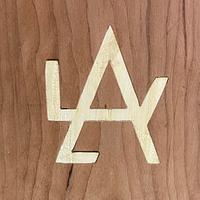Share your craft projects
Make new craft buddies
Ask craft questions
Blog your craft journey
It depends a little on whether you want the finish to actually be distressed or just look distressed. If you want it smooth, you probably do not want to create dents and such. You can use a torch to lightly char it and sand it back but the look you show looks more like smeared and splotchy stain than charring. Pine is naturally splotchy so that may work to your advantage. For that look, I would first sand it smooth just as you normally would to prep for a finish but not above 150 grit. You want the grain to remain fairly open to stain so it will absorb irregularly and splotch. You can raise the grain by wiping with water and not sanding it before you apply a stain. I would then get a dark stain and just haphazardly wipe it on with a cloth and even drip some a little heavy in spots but not wipe it off right away. You might need to thin the stain a little for a first pass and then full strength for a second pass but apply it heavier in places, especially any that look like they were splotchy to accent those areas. As you are applying the stain, wipe in random directions across the grain or in circular patterns but you probably want to minimize how many times you wipe each area. If you use a water based stain, you may be able to use a fairly wet rag to wipe off the excess stain, wiping across the grain and in random patterns and then dry the surface with a dry rag. Because you will have raised grain, you will probably want to lightly sand with a higher grit but sand by hand being carefully not to remove too much of the stain. If the pine is splotchy you can probably sand more because the stain will have absorbed deeper in those spots. Finish with what ever top coat you want.
Another option is to buy some spray paint and just randomly spray splotches onto the surface. You can start by just sort of spritzing the entire surface and then put some darker areas. After the paint dries, you can cover the entire surface with whatever topcoat you want.
It might not be a bad idea to cover the enter surface with a sanding sealer or shellac based primer like Zinsser Seal Coat before you apply whatever topcoat you want. Minwax has a water based sanding sealer for poly that I have had good luck with. The sealer will allow you to sand it smooth after distressing the stain and still get a smooth coat with whatever gloss level you want. The shellac sealer may also help if you use a spray paint that may not be compatible with the top coat.
Do your experimenting on the bottom of the table top. You can try different techniques to figure out which ones give you the look you want and you can always sand it back and start over if you do not like it
Another option is to buy some spray paint and just randomly spray splotches onto the surface. You can start by just sort of spritzing the entire surface and then put some darker areas. After the paint dries, you can cover the entire surface with whatever topcoat you want.
It might not be a bad idea to cover the enter surface with a sanding sealer or shellac based primer like Zinsser Seal Coat before you apply whatever topcoat you want. Minwax has a water based sanding sealer for poly that I have had good luck with. The sealer will allow you to sand it smooth after distressing the stain and still get a smooth coat with whatever gloss level you want. The shellac sealer may also help if you use a spray paint that may not be compatible with the top coat.
Do your experimenting on the bottom of the table top. You can try different techniques to figure out which ones give you the look you want and you can always sand it back and start over if you do not like it
--Nathan, TX. Hire the lazy man. He may not do as much work but that's because he will find a better way.









